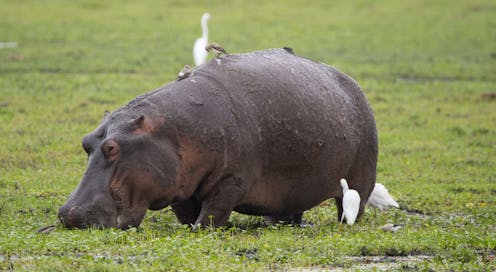
In 1872 Leland Stanford, the founder of California’s Stanford University, hired an eccentric inventor named Eadweard Muybridge to help resolve a supposed (but undocumented) bet: did a trotting horse’s feet leave the ground with all four feet or not?
Muybridge was a skilled photographer and managed to get blurry snapshots of an “airborne” horse in mid-trot – an example of how the naked eye alone can’t capture fast, subtle motions. He went on, alongside others, to establish what became cinematography. He also continued to capture images of many animals moving, trying to catch them airborne. Of another large animal, the hippo (which he did not photograph) Muybridge wrote:
On dry land it is hardly probable that its fastest gait can be other than the amble [meaning fast but still four-beat, lateral sequence]; possibly a trot, but with a brief period, if any, of non-support.
Was he right? As a scientist whose research partly focuses on how giant land animals like rhinos, elephants, and giraffes move and how gravity uniquely constrains how athletic they can be on land, I’ve long wondered how hippos move on land.
Most people probably think of hippos in terms of their activities in the water, where they do spend much of their time. But they are amphibious animals that spend about one-third of their time on land. At giant sizes (typically around 1400 kg) similar to those of young elephants, hippos should be ponderous and slow on land, especially as they must also be adapted for life in the water and look so bulky. But what seems likely and what is true are not always the same. That’s where the science comes in, to address questions with evidence. We know hippos don’t fly; they have no wings and are too big; but what can they truly achieve under gravity’s hefty pull?
In a recent study, we showed that hippos trot – but at fast speeds they can become airborne with all four feet off the ground at once. This is remarkable because now we know that hippos are one of the largest animals that still can get airborne at fast speeds and yet they are also adapted for a semi-aquatic lifestyle.
A simple experiment
Studying the existing literature about hippo locomotion, I found it wasn’t clear what range of gaits or sequence of footfalls hippos used.
Some studies said they used a “lateral sequence” walking pattern – a “four-beat” gait, contacting the ground with left hind, then left fore, then right hind, then right fore feet.
Others stated that hippos only used a “trotting” pattern even at slower speeds. Here trotting doesn’t mean moving at a moderate speed like a jog. In scientific analysis of locomotion, much as in other areas such as equestrian sport, a trot is a “two-beat” gait in which diagonal limbs move in near-unison, with left hind and right front feet contacting the ground, followed by right hind and left front feet about half of a footfall cycle (“stride”) apart.
Few scientific studies had even considered what hippos do when they move quickly on land. There were some observations that, at least at moderate speeds, hippos trotted.
So I designed a very simple experiment, analogous to what Muybridge did but today a mundane activity: taking digital videos of hippos moving at a range of speeds.
I sent my undergraduate veterinary student, Emily Pringle, to Flamingo Land Resort in North Yorkshire in the UK, armed with basic GoPro cameras, to capture videos of their two adult hippos.
She noted during the two days of intermittent filming that the hippos were slow; just walking. It wasn’t a surprise. Not only did the hippos not spend much time on land (and were out of sight in their barn at night), but there was no way to motivate them to move quickly – they live a safe life.
There was a second part to our plan. The internet is full of videos of wildlife, so we searched Youtube and other websites for more videos of hippos moving at a range of speeds on land, to “bulk up” our data sample. This helped to put our video of the two zoo hippos into a broader context. We hoped to find some footage of hippos moving as quickly as they could, under more motivated (probably wild) conditions.
We did.
Video evidence
We collected 169 strides from 46 video clips of 32 hippos. Most of it was slow walking, but all of these walking strides involving trotting patterns. It’s clear that hippos prefer to trot rather than using a four-beat lateral sequence pattern, even at slow speeds.
The videos of wild African hippos, and a couple from zoos, contained the most exciting finding.
About 14 of our 46 hippo videos showed at least brief periods of “non-support”, as Muybridge termed it – becoming airborne with all four feet off the ground.

The fastest sequences showed hippos getting airborne for around 0.3 seconds. That might seem really brief but it’s longer than a single foot might be on the ground (as little as 0.2 seconds). Furthermore, the nervous system of a big animal like a hippo would involve lengthy delays in response to a stumble, so those airborne periods could be risky.
Our findings emphasise how odd hippos’ locomotion is on land. Unlike most other mammals, especially larger ones, they just trot, from slow to fast speeds. We weren’t able to measure precisely how fast hippos can move, but I hypothesise that they’re probably not much faster than elephants, which I’ve shown before to move at up to 25 kph (with a lateral sequence “amble”, never airborne).
Their ability to get even briefly airborne means that hippos are relatively more athletic than elephants, but still less athletic than white rhinos, which can be as big as a hippo yet can gallop and thus be airborne, and probably faster than hippos. This variety of locomotor abilities, expanded by other very large animals that I’ve studied such as giraffes, and even extinct dinosaurs, shows two general patterns.
First, even at giant sizes over 1000 kg, there still remains a variety of athletic abilities that might be usable, such as moving faster than a slow walk, or even going airborne.
Yet second, at such sizes, inevitably there is a decline in maximal speed. As size increases, sooner or later some athletic abilities such as becoming airborne must be sacrificed, in return for the many benefits of giant size.
John R. Hutchinson does not work for, consult, own shares in or receive funding from any company or organisation that would benefit from this article, and has disclosed no relevant affiliations beyond their academic appointment.
This article was originally published on The Conversation. Read the original article.







